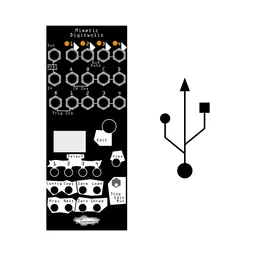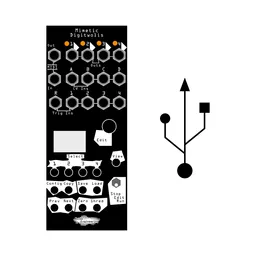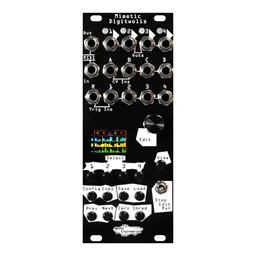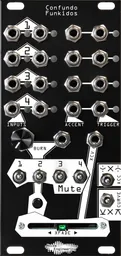Yes. You read that right. The wait is over. This is not a test. Your rhythm-crossfading dreams are about to come true, and they’re better than ever.
In what is probably our most highly requested module launch ever, we’re very happy to announce Confundo Funkidos, the successor to the cult classic Confundo Funkitus. With completely revamped hardware, revised firmware, and a host of new features, Confundo Funkidos builds on the legacy of the original with all the features you know and love, plus all-new ways to patch.
If you can’t wait any longer, place your preorder at your favorite retailer or the Noise Engineering webshop today: Confundo Funkidos ships on January 9. Then, while you’re waiting by the mailbox, read on to learn about how it works and the story behind it.
What is Confundo Funkidos?
Confundo Funkidos is a unique module that, at its core, is a rhythm crossfader. The original inspiration comes from the world of DJ mixers, which make it easy to crossfade between grooves. We decided to embrace the power of modular and instead of crossfading between audio sources, Confundo Funkitus allows you to crossfade between two sets of trigger patterns before they’re routed to your percussion voices.

Confundo Funkidos has four channels, each with a pair of trigger inputs and a trigger output. The crossfader allows you to blend between those input pairs by swapping between grooves, combining patterns, or applying probability on the fly.
Additionally, each channel features a mute switch, making it easy to bring parts in and out of your patches.
Finally, the BURN button combines the inputs and routes each trigger to all the outputs, while still respecting the crossfader position.
That’s a basic overview of the features available on Confundo Funkidos that were borrowed from the original – and if you want to use it like the original, you can. But we didn’t stop there!
What’s new in Confundo Funkidos
When we decided to bring CF back, we decided to make a few enhancements and additions. We’ve learned a lot since the first version, and we put all of our knowledge and experience to work.
First, the technical changes: the trigger outputs have been standardized to a width of 5ms, so overlapping gates at the inputs will give more predictable results. We also did extensive testing of the timing of a whole bunch of trigger sequencers in our systems, so unwanted flamming and other timing artifacts are avoided as much as possible. We also revamped the hardware, adding multicolored LEDs to the outputs. More blinky LEDs make things sound better.
The biggest addition is the four ACCENT gate outputs. It’s easy to use a gate signal as a simple modulation CV to bring a drum voice to life, and many percussion modules have built-in accent inputs that respond to gates. The accent gates go high or low based on one of three algorithms: two are based around the trigger output of the next channel, and one is based on the opposite trigger input. This means that you’ll automatically get dynamic accent patterns at the outputs based entirely on the patterns you patch to the inputs.
A more subtle change is the MUTE switches: they’re now three-position switches. In the top position, channels output triggers and gates as you’d expect. In the bottom position, channels are completely muted. But in the middle position, channels output triggers, but don’t output accents, and are excluded from BURN behavior: that means you can use BURN to create a fill on, for example, just your hats and snares, but not on your kicks and toms.
Speaking of BURN, it’s been enhanced, too! A little-known feature of the original module was that the BURN jack was a CV input. As CV at that input increased, the probability of a trigger at an input being routed to any output increased, with all triggers going to all outputs at max. The button just maxed out the CV value. On Confundo Funkidos, we added a potentiometer to BURN, so that you can create more interesting fills right on the panel. BURN also interacts with the accent outs: past 12 o’clock on the potentiometer, the probability of triggers being sent to all outputs is maxed, and the probability of the accent outputs changing state on a trigger increases.
So nice we made it twice
The original Confundo Funkitus was released way back in 2016 – almost 10 years ago at this point. While it was one of the first NE releases, it retained a bit of a cult following: it’s a fun addition to any performance system, and is at home mixing together percussive rhythms or triggers for melodic patterns.
In 2018, some of the parts on the original increased in price rather dramatically. When we looked at what it cost to make the module, we realized that we couldn’t sell it for a reasonable price, and we had to kill it.
Ever since it was discontinued, we’ve had requests for it to make a return. In fact, it’s our most requested legacy module! We decided that the perfect way to kick off a new year was to bring it back for 2025, so we started development of a new version.
Initially, we considered just re-releasing the original version as-is. But after some discussion, we realized there were a number of things we wanted to add, and a couple of things that we could make even better. After all, we like to think we’ve learned a few things since 2016! After a long discussion and a number of mockups (a huge 20 HP version was at one point proposed), we settled on the final hardware design. There were a couple of hiccups along the way, but the first prototype was 90% of the way there (other than the slider being backward…happens to the best of us.).
Firmware development was quite a fun endeavor. The first revisions took care of nailing the functionality of the original module (a new CPU meant starting from scratch), and the next couple of weeks were spent figuring out how accents and burn should work and nailing the module’s timing. Deciding how accents should be generated was particularly challenging, as we wanted a set of algorithms that would generate interesting accent patterns with a wide variety of input rhythms.
We also spent a day figuring out latency behavior: we wanted the input-to-output delay to be unnoticeable, but also accommodate the variety of timings found in various Eurorack modules. Eventually, we found that a round-trip trigger latency of 750uS with a maximum retrigger frequency of 25mS allowed us to combine as many sources as possible without unwanted artifacts or noticeable delay. That window also allowed us to build in accent prefire: the accent output changes state 250uS before the trigger output, so you’ll always hear an accented or unaccented note at the correct time.
There was also the challenge of desk space: routing 16 signals takes up a lot of cables!









